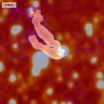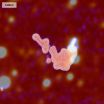(Press-News.org) Trained volunteers are as good as professional astronomers at finding jets shooting from massive black holes and matching them to their host galaxies, research suggests.
Scientists working on citizen science project Radio Galaxy Zoo developed an online tutorial to teach volunteers how to spot black holes and other objects that emit large amounts of energy through radio waves.
Through the project, volunteers are given telescope images taken in both the radio and infrared part of the electromagnetic spectrum and asked to compare the pictures and match the "radio source" to the galaxy it lives in.
The results from the first year of the Radio Galaxy Zoo project, led by Dr Julie Banfield of the ARC Centre of Excellence for All-Sky Astrophysics and Dr Ivy Wong at the International Centre for Radio Astronomy Research, were published today in the Monthly Notices of the Royal Astronomical Society.
Before unleashing the eager crowd of online volunteers, the research team tested the same 100 images on both the trained citizen scientists and an expert team of ten professional astronomers.
"With this early study we've comfortably shown that anyone, once we've trained them through our tutorial, are as good as our expert panel," Dr Banfield said.
"The volunteers have already 'eyeballed' more than 1.2 million radio images from the Very Large Array in New Mexico and CSIRO's Australia Telescope Compact Array, and infrared images from NASA's Spitzer and WISE Space Telescopes."
In one year, the citizen scientists managed to match 60,000 radio sources to their host galaxy--a feat that would have taken a single astronomer working 40 hours a week roughly 50 years to complete.
"In the upcoming all-sky radio surveys, we are expecting 70 million sources--10 per cent of which will not be classifiable by any of the computer algorithms currently available," Dr Wong said.
"These 10 per cent will have weird and complex structures that need a human brain to interpret and understand rather than a computer program."
"We have asked our volunteers to identify 170,000 radio sources that are most likely to have unusual structures using current datasets, so we are better prepared for what we could find in the upcoming next generation radio surveys."
At Radio Galaxy Zoo, professional astronomers talk to the participants every day on a dedicated forum and often ask them to look out for objects of interest.
"One member of the Radio Galaxy Zoo science team in Mexico loves looking for 'giants'--jets longer than a megaparsec, or about 125 times the distance from Earth to the centre of the Milky Way. These are typically very, very old radio jets," Dr Wong said.
INFORMATION:
More Information:
Dr Ivy Wong is based at the UWA node of the International centre for Radio Astronomy Research (ICRAR), a joint venture between Curtin University and The University of Western Australia with support and funding from the State Government of Western Australia.
Dr Banfield is part of "The Evolving Universe" research theme of the Australian Research Council Centre of Excellence for All-sky Astrophysics (CAASTRO).
Radio Galaxy Zoo is an online project in which citizen scientists are helping scientists identify galaxies hosting jet-emitting massive black holes. See radio.galaxyzoo.org for more.
Original publication details:
'Radio Galaxy Zoo: host galaxies and radio morphologies derived from visual inspection' published in the Monthly Notices of the Royal Astronomical Society, Oxford University Press on 7/09/2015. Available online at http://arxiv.org/abs/1507.07272.
Supporting Multimedia:
Images available from: http://www.icrar.org/black-hole-hunters
Contact Details:
Dr Ivy Wong (ICRAR/The University of Western Australia)
Ph: +61 402 828 363 E: Ivy.Wong@icrar.org
Dr Julie Banfield (ARC Centre of Excellence for All-Sky Astrophysics)
Ph: +61 415 753 414 E: Julie.Banfield@anu.edu.au
Pete Wheeler (Media Contact, ICRAR)
Ph: +61 423 982 018 E: Pete.Wheeler@icrar.org
Dr Wiebke Ebeling Davies (Media Contact, ARC Centre of Excellence for All-Sky Astrophysics)
Ph: +61 423 933 444 E: Wiebke.Ebeling@curtin.edu.au
A rare, deadly form of skin cancer known as desmoplasmic melanoma (DM) may possess the highest burden of gene mutations of any cancer, suggesting that immunotherapy may be a promising approach for treatment, according to an international team led by UC San Francisco scientists. One of these mutations, never before observed in any cancer, may shield nascent DM tumors from destruction by the immune system and allow further mutations to develop.
"The focus of our lab has been to show that there's not just one 'melanoma' but many different types," said senior author Boris ...
In the course of billions of years continents break up, drift apart, and are pushed back together again. The cores of continents are, however, geologically extremely stable and have survived up to 3.8 billions of years. These cores that are called cratons are the oldest known geological features of our planet. It was assumed that the cratons are stable because of their especially solid structure due to relatively low temperatures compared to the surrounding mantle. A team of German-American scientists now discovered that these cratons that were assumed to be "as solid as ...
A novel research tool developed by researchers from the Institute of Psychiatry, Psychology & Neuroscience (IoPPN) at King's College London has identified a link between the negative symptoms experienced by people with schizophrenia and adverse clinical outcomes.
Negative symptoms can include poor motivation, poor eye contact and a reduction in speech and activity. As a result, people with schizophrenia often appear emotionless, flat and apathetic. These contrast with positive symptoms - psychotic behaviours not seen in healthy people, such as delusions or hallucinations.
Published ...
This news release is available in German. The scientific world was astonished when, in 2011, Chinese researchers claimed to have found evidence suggesting that minute fragments of plant genetic material - so-called microRNA molecules - of rice ingested from food could play a role in regulating physiological processes in the human body. If this is indeed true, it might even be possible to deliberately modify human physiological functions via this route, for instance by incorporating microRNAs into novel functional foods. As a strategy, this holds considerable potential. ...
Secukinumab (trade name: Cosentyx) has been approved since January 2015 for adults with moderate to severe plaque psoriasis. The German Institute for Quality and Efficiency in Health Care (IQWiG) examined in a dossier assessment whether this drug offers an added benefit over the appropriate comparator therapy. Such an added benefit cannot be derived from the dossier, however: In patients who are candidates for systemic treatment, an indirect comparison provided no suitable data because the minimum study duration had not been reached. In adults in whom other systemic treatments ...
This news release is available in German. The recovery of waste heat in all kinds of processes poses one of the main challenges of our time to making established processes more energy-efficient and thus more environmentally friendly. The Spin Seebeck effect (SSE) is a novel, only rudimentarily understood effect, which allows for the conversion of a heat flux into electrical energy, even in electrically non-conducting materials. A team of physicists at Johannes Gutenberg University Mainz (JGU), the University of Konstanz, TU Kaiserslautern, and the Massachusetts Institute ...
PULLMAN, Wash.--Washington State University researchers have discovered how to stretch metal films used in flexible electronics to twice their size without breaking.
The discovery could lead to dramatic improvements and addresses one of the biggest challenges in flexible electronics, an industry still in its infancy with applications such as bendable batteries, robotic skins, wearable monitoring devices and sensors, and connected fabrics.
The work was led by Rahul Panat and Indranath Dutta, researchers in Voiland College's School of Mechanical and Materials Engineering, ...
September 8, 2015, New York, New York- Data from a three-country survey seeking to understand beliefs of adults on the role of diet for optimal health, as well as consumption of key micronutrients including Omega-3 and Vitamin D, will be published in the November/December issue of Nutrition Today. The survey of 3,000 American, British and German adults found that 72 percent reported having a "healthy" or "optimal" diet and more than half (52 percent) believed they consume all the key nutrients needed for optimal nutrition through food sources alone. However, the prevalence ...
Extinct Mediterranean forests of biblical times could return and thrive in warmer, drier future.
The Mediterranean has cradled humanity and our cities, farms, domesticated animals, and logging habits for many thousands of years. During the last 5 to 8 millennia, as people developed farming and settled in cities, the landscape has gradually changed from a thick canopy of trees to open grass and shrubs. The ghosts of Sicily's extinct evergreen forests of holm oak (Quercus ilex) and olive trees (Olea europaea) remain in the record of pollen left in the lakebed sediments. ...
A pair of studies suggests that a region of the brain - called the insular cortex - may hold the key to treating addiction. Scientists have come to this conclusion after finding that smokers who suffered a stroke in the insular cortex were far more likely to quit smoking and experience fewer and less severe withdrawal symptoms than those with strokes in other parts of the brain.
"These findings indicate that the insular cortex may play a central role in addiction," said Amir Abdolahi Ph.D., M.P.H., lead author of the studies. "When this part of the brain is damaged during ...


